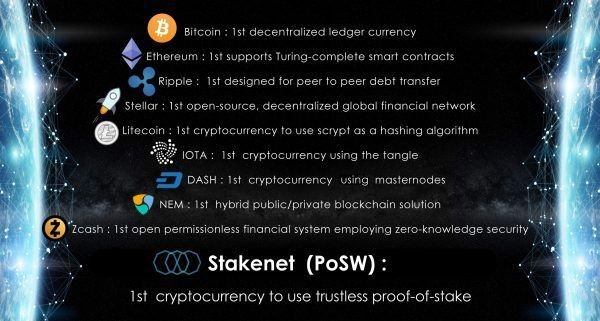CCPOS : Cross Chain Proof of Stake
NEW: DIFFERENT THAN ATOMIC SWAP

Programming protocols themselves to interact with the ‘rules’ on completely separate chains other than their own
CCPOS would also enable an ability for users to “light-swap” (atomic swap without having to DL an entire 2nd blockchain) directly on STAKENET protocol, without the need of a 3rd party centralized service
CCPOS will be added to STAKENET during 2018: STAKENET ROADMAP
POSW is going to be rebranded and thanks a fork from PIVX will be born STAKENET.

You can read below the full article written by one of the STAKENET devs explaining what is CCPOS and the benefits and differences with Atomic Swap.
(It's a copy paste, I hope the Steemit robot won't appear saying: Hi! I am a robot. I just upvoted you! I found similar content that readers might be interested in: PoSW Weekly : CCPOS (Cross Chain Proof of Stake)
PoSW Weekly | CCPOS (Cross Chain Proof of Stake)
The value of blockchain is its concept of immutability. This strength however brings real world complexities difficult to manage in use cases, as blockchain was not conceived to adapt easily and faces challenges working with rigid models limiting its agility. For a new breakthrough to be adopted, often a coin must often change its “rules” and undergo what is called a “Hard Fork”. In a large network this can be very damaging as it requires consensus amongst all nodes to run new software, possibly fragmenting its community and sometimes changing its history. There is also nothing to stop forks from occurring again and again at any point in the future, diluting a coins value and market capitalization. There may be solutions however, using recently developed technologies and advancements, in this article we will discuss a few. If we can achieve these goals, it would give teams a better, smoother model to conduct operations.
In the last write up we discussed the impact of cross chain exchanging specifically atomic swaps of one coin to another through a peer to peer ‘lightning network’. Here we will discuss the possibility of programing protocols themselves to interact with the ‘rules’ on completely separate chains other than their own. This ability would allow communities to utilize new technology, inventions, and advancements ensuring they are able to adapt and adopt easily as well as remain competitive.
Cross chain proof of stake (CCPOS)
An atomic swap is essentially proof — a user is proving he has transferred funds from one account to another and thus its contract terms are satisfied. A verification mechanism on the other end is observing making sure the first user does act honestly and is true to his promise. If all is good the contract is allowed to execute, if not they are able to refute — cancelling the contract. Using this method a user could also move funds to himself — proving he owns a stake in the 1st chains currency. This proof could be broadcasted on chain #2 (and verified using atomic swap functionalities) that our user does indeed possess a stake in the 1st chain. The second chain’s protocol might then allow for an appropriate response in light of this ‘proof of stake’. This could be in the form of unlocking privileges, rewards, or access to special features. Ownership on the first chain could even be used as “fuel” for its sister chains, creating a hierarchy while avoiding fragmentation.
This would increase the origins (1st chain’s) value greatly as any new advancements can be adopted into the ecosystem, using the stability, infrastructure and community from the original chain. What would result is an intra-network of blockchains we call “Inter Chain Clusters”.
Inter Chain Cluster
These Clusters have inter dependent traits to one another, giving additional value to users within a given network. They still would however be able to communicate, sync, and partake in all other features allowed through those running on a lightning network. If the lightning network is analogous to an “internet” allowing communication to different blockchains, this would be similar to a ‘LAN’ — a group of local chains having special rules relative to one another, but also able to communicate to the outside world.
Because lightning nodes are custom built to each chain, one could reprogram and construct rules from scratch with specialized interdependence in mind. So long as the new chains have code to be both lightning compatible as well as cluster compatible it will allow room for flexibility in all other aspects of building and programming for experimentation and invention. This will allow new technologies to be quickly integrated as a framework will exist satisfying all pre requirements needed allowing developers room to operate quickly and freely.
We should stress that this goes radically beyond the concept of ICOs being run on the Ethereum chain for example, as new projects wouldn’t be restricted to being token-based solutions on the same chain. Instead, they’d have their own chains, and subsequent chains for secondary purposes, with virtually unlimited flexibility. As they’d be ‘tethered’ to our main chain — holders, masternode operators, and core team members will all benefit.
Why has this not been done?
One of the main limitations of atomic swaps is the user must have 2 blockchains — his own as well as that which he intends to interact with in order to verify the terms of his contract are met. He needs both so he can physically refute if terms are not met or allow it to execute if he sees nothing wrong. This method causes limitations however as a human is needed for this entire process to function. In order for cross chain proof of stake to be possible it requires complete autonomy on the part of the protocol.
In our case utilizing masternode functionalities to both monitor, and verify will solve this issue. Allowing masternodes to contain databases of 3rd party chains, (specifically our sister chains) while watching for and verifying specific actions allows us to autonomously cross chain communicate via the protocol. In addition to CCPOS this would also enable an ability for users to “light-swap” (atomic swap without having to DL an entire 2nd blockchain) directly on our protocol, without the need of a 3rd party centralized service.
Delegating CCPOS responsibilities to masternodes would also provide an added income stream as new fees and rewards would exist associated with these cross chain verifications. If a sister chain increases in popularity and demand, ROI on main chain masternodes would rise as proving your stake on chain #1 would be the only way to unlock given actions on chain #2 — & utilizing our masternodes would be the only way to accomplish this proof.
Maintaining Agility
In a world of open sourc, it can be difficult to protect new innovations from being forked, spun, and implemented in new and sometimes better models. As we diverge from traditional ownership (patents, copyrights ect) we must learn to preserve value in this new environment. No better could this be done through engineering protocols themselves to respond to original decentralized master chains. The result would be not centralized control but a hierarchical control (HC) with masternode owners from an origin chain determining the direction, development, and purpose of the given inter chain cluster.
Platforms will soon rise eclipsing bitcoin, and ability for chains to adapt and evolve will be critical, as those that cannot will fade, be replaced and forgotten. We will see chains begin to combine into greater cohesive bodies where at its core lies a decentralized system growing proportionately with breakthroughs and advancements in the greater field of cryptocurrency. Rather than combat disruption we will position ourselves to adopt disruption — our community will secure future value and exposure to new trends simply by holding our asset, and our masternode owners will also benefit as their added service in verifying these cross chain proof of stakes would increase fees, rewards, and overall ROI giving us definitive value moving forward.
Very nice post!!
STAKENET will be a very good coin! Imagine when STAKENET will be offering staking service to other POS coins...
Really Nice post @greensmile, STAKENET is really a gamechanger. If you want to you should check out my recent post about DTube!
This is a very good post. Thanks for posting, there is future for STAKENET